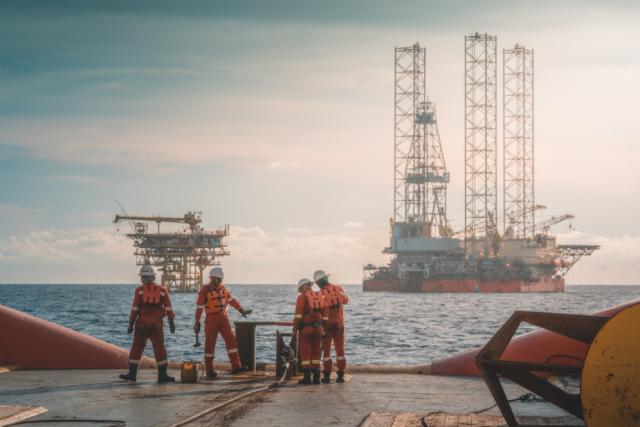
(Source: Shutterstock.com)
Barely recovering from the last downturn, E&P companies entered 2020 with measured optimism for exploration prospects. However, after the oil markets collapse earlier this year, new discoveries reached historic-lows and the oil and gas sector recorded its weakest-performing first-half in decades.
Top-level executives in the oil and gas industry recently discussed these challenges facing the sector as well as its path to recovery during a Business of Applied Geophysics session at Society of Exploration Geophysicists’ (SEG) virtual SEG20 conference.
Panelists agreed that digitalization, partnerships and adopting new ways of working are critical for the survival of the E&P sector.
“While the future is largely uncertain, one thing is clear: We will not survive without fundamentally evolving and changing the way we work,” said Maurice Nessim, president of WesternGeco, the geophysical services product line of Schlumberger Ltd.
Exploration budgets, which has always been a target for capex cuts given its long lead time and discretionary nature, is projected to drop further this year. “All the geographical areas continue to be impacted but we are observing the largest impacts onshore North America where exploration activities and investment have come to a halt,” Nessim said.
“We have lost more than $4 billion in the seismic business since 2014,” he continued. “Keeping in mind that the [exploration] business is technologically advanced, it has invested more than $2.5 billion in research and development, which the sector has not been able to recover and will not be able to recover in the future.”

Check out our executive Q&A with SEG Session Chair Bill Abriel on the business of geophysics.
The downturn has caused massive layoffs and has made the workforce weaker, especially in the area of geoscience expertise, which Nessim said cannot be easily replaced.
Outlining strategies for survival, he believes the exploration sector needs to diversify beyond oil and gas, adopt new ways of working, accelerate digital transformation and collaborate through partnerships.
So, what does the long-term outlook of exploration look like?
“Exploration is not dead, but it’s not very healthy,” he said. With significant cuts in exploration spending since 2014, he added that the long-term outlook of exploration isn’t very promising.
Others on the panel expressed a similar sentiment.
“Exploration is not dead, but you’re going to see a lot of consolidation in the space with two or three companies focused on exploration…those who can operate efficiently and address risks at low-cost,” said Murray Christie, executive director of geoscience and engineering commercialization of energy at IHS Markit.
“Exploration is not dead,” added Mike Yates, geophysical technology lead at Apache Corp. “It’s currently a much bigger focus than any of the exploitation work…the emphasis is currently on what’s next and where we are going to find the hydrocarbons.”
The panelists also expressed optimism in the area of digital platforms being used for the recovery of the exploration sector.
Nessim said that the only way out of the crisis is to collaborate with tech companies.
“There is no money left in the geophysical industry for service providers to do more,” he said. “It’s an opportunity for us to lean on the tech industry, which is in a different cycle, and to work more closely with them, we need our end-users, which are the NOCs and operators, to be able to partner with us too. This is probably one of the few ways to get out of the crisis that we are in now.”
As part of that collaboration, Sverre Brandsberg-Dahl, director of technology and research at Microsoft, said he believes the path forward is to infuse the expertise of E&Ps with their processes of data science.
“We are not going to be a service company…we are here to partner with the exploration industry and facilitate the digital transformation while looking for ways to augment collaboration,” Brandsberg-Dahl said.
Recommended Reading
Petrie Partners: A Small Wonder
2024-02-01 - Petrie Partners may not be the biggest or flashiest investment bank on the block, but after over two decades, its executives have been around the block more than most.
Kissler: OPEC+ Likely to Buoy Crude Prices—At Least Somewhat
2024-03-18 - By keeping its voluntary production cuts, OPEC+ is sending a clear signal that oil prices need to be sustainable for both producers and consumers.
Sunoco’s $7B Acquisition of NuStar Evades Further FTC Scrutiny
2024-04-09 - The waiting period under the Hart-Scott-Rodino Antitrust Improvements Act for Sunoco’s pending acquisition of NuStar Energy has expired, bringing the deal one step closer to completion.
The OGInterview: Petrie Partners a Big Deal Among Investment Banks
2024-02-01 - In this OGInterview, Hart Energy's Chris Mathews sat down with Petrie Partners—perhaps not the biggest or flashiest investment bank around, but after over two decades, the firm has been around the block more than most.
Shell’s CEO Sawan Says Confidence in US LNG is Slipping
2024-02-05 - Issues related to Venture Global LNG’s contract commitments and U.S. President Joe Biden’s recent decision to pause approvals of new U.S. liquefaction plants have raised questions about the reliability of the American LNG sector, according to Shell CEO Wael Sawan.





